Geneva in December 1922
By Anne Dealy, Director of Education and Public Information
I always enjoy reading historic newspapers. They give you a window into the world of the past, telling of major historic events but also about the mundane and everyday aspects of life. I recently read through issues of the Geneva Daily Times for December 1922, to see what was happening in Geneva 100 years ago. It gave me insight into how decisions made then still affect us today.
In those days, world and national news dominated the front page of the daily paper. In December 1922, most of the front-page news focused on the fallout from World War I, including the debt the European allies owed the United States. Debates were going on about the extent of reparations Germany would have to pay and whether JP Morgan would lend Germany the funds to finance its payments. The newspaper was also reporting on the Irish Civil War, violence between fascists and communists in Italy, and Christian refugees fleeing oppression in Turkey. You can readily see the groundwork being laid for the conflicts of the 20th century.
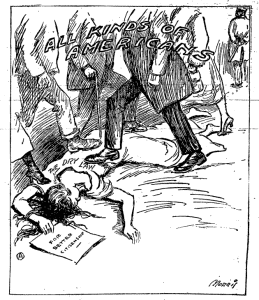
Many Americans in 1922 ignored the prohibition against drinking liquor as this political cartoonist pointed out.
National news focused on enforcement of the Volstead Act (Prohibition) and the growth of crime due to illegal alcohol and narcotics trafficking. There was also a nationwide coal shortage because of a miners’ strike, and the United States Post Office had a “shocking” deficit of $64 million—in 2021 it was $6.9 billion. Terrible Atlantic storms were battering steamships heading to the east coast and led to the deaths of more than 40 people at sea. The outlook in business and commerce was predicted to be good, and traffic on the Barge Canal was up from prior years. Al Smith had just been elected governor of New York and his inaugural crowds were expected to break records.
The transformation of the nation’s transportation network was underway. In the 1800s, road building was funded by landowners, local communities, and the states, with no overall national plan or standards. Use of the bicycle and later the automobile showed the flaws of this system, and more comprehensive national planning for roads began in the late 1890s. The director of the National Bureau of Public Roads, Thomas MacDonald, stated on December 7 that they had completed 10,000 miles of federal roads in the prior year and just as many state and local roads had been built. The Federal Highway Act of 1921 had set out a plan for an integrated national system of highways. MacDonald reported great progress in building these roads and creating a method for designing and financing highways. 9.3 million of these funds would be spent on building roads in New York. This was the start of the national system of highways which enabled the phenomenal economic growth of the 20th century. It was the basis of the transportation system which we still use today, one largely dependent on the automobile and petroleum.
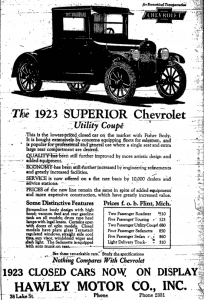
Automobiles exploded in popularity in the 1920s and were widely available in Geneva to those who could afford one.
Fatal automobile accidents, both locally and around the nation, were reported daily. In New York State, 1,967 people died in motor vehicle accidents in the first 11 months of 1922 with 1,000,000 cars on the road. Compare this to 1,098 on average in 2012-2014 with over 4 million cars. Great concern was expressed at the number of accidents at highway grade crossings and the need to make these safer. With accidents on the rise, people started to argue for a system of licensing to prevent reckless driving. The only requirement to drive in the state was to be at least 18 years old. However, even young children could legally drive if accompanied by a chauffeur or the owner of the vehicle. The New York State Automobile Association argued for the creation of a Department of Motor Vehicles to address these problems. It would issue licenses, collect taxes and fines, and get police to enforce traffic laws.
People were still figuring out the rules for cars, as two drivers discovered when they hit a Junius farmer with a load of logs. He was charged with “driving without a display of lights,” but the charges were dismissed when the judge determined the law only applied to wheeled vehicles and not the sleigh the farmer was using to haul the logs on the road at night. Although cars were the wave of the future, they still shared the road with wagons and sleighs in many areas.
Regulation and standardization were emerging in many areas of American life. Although no driver’s license existed, New York State required registration tags for cars which had to be renewed annually. Unlike in previous years when there was a grace period, those who failed to renew theirs were told that they would be arrested after December 31. The state also released a list of headlights approved for cars in the state. Owners would have to change them if theirs were not on the list. A congressman proposed legislation to have all citizens fingerprinted for their own protection. Western New York fruit growers proclaimed increased sales once they started packing their produce in a standardized way to compete with western farms. A state report on rural schools showed poor achievement among their students. It prompted recommendations to equalize funds for rural schools and require better teacher training for rural schoolteachers. Incentives were suggested for consolidating these small schools.
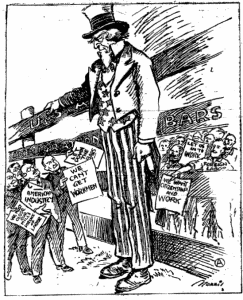
The 1920s brought the first numerical restrictions on immigration to the United States, as quotas for immigrants from nations seen as less desirable were imposed.
Intolerance in many forms was also apparent. The foreign-born population of the U.S. was 13% in 1920. Many Americans objected to the immigrants that had flooded the country from southern and eastern Europe during the previous 30 years. In the 1920s, the U.S. began to restrict immigration from countries outside northern Europe. A resolution was passed by a New England genealogy group requesting legislation to prevent immigrants from changing their surname to that of anyone historically famous in the colonial or Revolutionary period. There were frequent reports on the activities of the KKK in New York and elsewhere. The pastor at First Presbyterian Church gave a sermon railing against the evils of the KKK and “its program of opposition to Catholics, Jews and negroes.” Racist minstrel shows were regularly performed at local theaters and by service organizations.
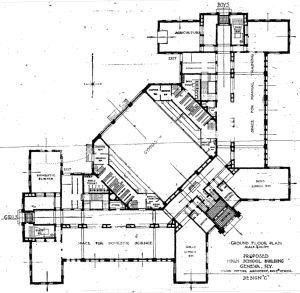
The plans for the new Geneva High School, published in the Geneva Daily Times ahead of the approval vote, 1922.
Locally, residents voted overwhelmingly in favor of the construction of a new modern high school on Milton Street. The people were 1100 to 60 in favor of the proposal and even came out to vote as a major nor’easter hit the area. Train and trolley lines in Rochester and other cities were impeded, and country roads were impassable. Farmers had to find alternate routes to travel in Seneca County and mail carriers returned to using horses. There was a shortage of butter and eggs, and coal was scarce, as elsewhere. Two ice rinks were opening in Geneva for the winter. One at 390 Exchange Street was new and would include a building with a stove for heat and a pipe organ for music. The annual city Christmas tree was erected at Castle and Exchange Street. Newton Weatherly was exhibiting paintings in a downtown store window. Two days before Christmas, the Fairfax Building (Guard Building at Seneca and Linden) had a fire. The block had burned three times prior to this, in 1904, 1913 and 1917, and it would burn again in 1928. The 1904 fire cost the life of a music teacher who lived on the upper floors. The building’s exterior was extensively redone, probably after the 1917 fire. The 1922 fire doesn’t seem to have been that bad, as some tenants were back in the building later in the month.
Geneva in 1922 was not that different from Geneva today, even as it was completely different–no one is selling radium underwear in town these days. Still it is helpful to look at the past to get an impression of where we have been and to think about where we are going.

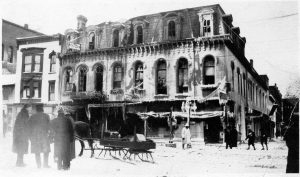
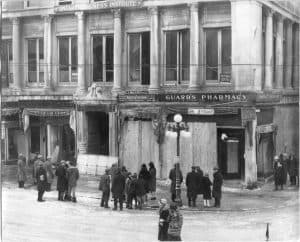
Anne, Great article about life and issue 100 years ago. Thanks
Thank you Anne for that very informative and interesting article.
Many similarities to today’s news.
What struck me in particular was the number of fatal car accidents in NYS in 1922.